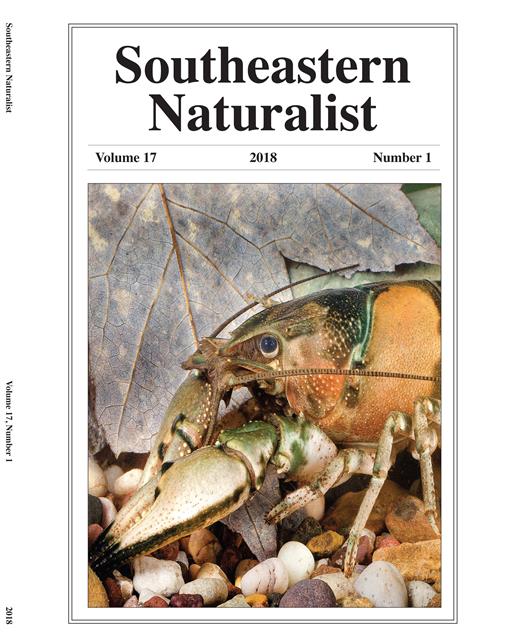Literature Cited
Arnold,
B.D.
2007. Population structure and sex-biased dispersal in the forest-dwelling vespertilionid bat Myotis septentrionalis. American Midland Naturalist 157(2):374–384. Google Scholar
Barbour,
R.W., and
W.H.
Davis.
1969. Bats of America. The University of Kentucky Press, Lexington, KY. 286 pp. Google Scholar
Caceres,
M.C., and
R.M.R.
Barclay.
2000.
Myotis septentrionalis. Mammalian Species 634:1–4. Google Scholar
Cooke,
C.W.
1936. Geology of the Coastal Plain of South Carolina. US Government Printing Office, Washington, DC. 218 pp. Google Scholar
Crnkovic,
A.C.
2003. Discovery of Northern Long-eared Myotis, Myotis septentrionalis (Chiroptera: Vespertilionidae), in Louisiana. Southwestern Naturalist 48(4):715–717. Google Scholar
Culver,
D.C.,
H.H.
Hobbs
III
,
M.C.
Christman, and
L.L.
Master.
1999. Distribution map of caves and cave animals in the United States. Journal of Cave and Karst Studies 61(3):139–140. Google Scholar
Frick,
W.F.,
S.J.
Puechmaille, and
C.K.R.
Willis.
2015. White-nose syndrome in bats. Pp. 245–262,
In
C.
Voigt and
T.
Kingston
(Eds). Bats in the Anthropocene: Conservation of Bats in a Changing World. Springer International Publishing, Cham, Switzerland. 606 pp. Google Scholar
Gargas,
A.,
M.T.
Trest,
M.
Christensen,
T.J.
Volk, and
D.S.
Blehert.
2009.
Geomyces destructans sp. nov. associated with bat white-nose syndrome. Mycotaxon 108:147–154. Google Scholar
Georgia Department of Natural Resources (GADNR). 2017. Georgia rare natural elements data portal.
Myotis septentrionalis.
Available online at http://gakrakow.github.io/natels/range_maps2.html?es_id=17848. Accessed 9 October 2017. Google Scholar
Grider,
J.F.,
A.L.
Larsen,
J.A.
Homyack, and
M.C.
Kalcounis-Rueppell.
2016. Winter activity of coastal plain populations of bat species affected by white-nose syndrome and wind energy facilities. PLoS ONE 11:1–14. Google Scholar
Hyun,
K.H.
2016. Endangered and threatened wildlife and plants; 4(d) rule for the Northern Long-eared Bat. US Fish and Wildlife Service, Department of the Interior. Federal Register 81(9):1900–1922. Google Scholar
Malde,
H.E.
1959. Geology of the Charleston Phosphate Area. US Government Printing Office, Washington, DC. 118 pp. Google Scholar
Menzel,
J.M.,
M.A.
Menzel,
W.M.
Ford,
J.W.
Edwards,
S.R.
Sheffield,
J.C.
Kilgo, and
M.S.
Bunch.
2003. The distribution of the bats of South Carolina. Southeastern Naturalist 2(1):121–152. Google Scholar
Morris,
A.D.,
M.J.
Vonhof,
D.A.
Miller, and
M.C.
Kalcounis-Rueppell.
2009.
Myotis septentrionalis Trouessart (Northern Long-eared Bat) records from the coastal plain of North Carolina. Southeastern Naturalist 8(2):355–362. Google Scholar
National Environmental Satellite, Data, and Information Service (NESDIS). 2017. Summary of monthly normals 1981–2010. Available online at https://www.nesdis.noaa.gov/. Accessed 4 October 2017. Google Scholar
North Carolina Department of Parks and Recreation (NCDPR). 2017. Mammals of North Carolina. Available online at http://www.dpr.ncparks.gov/mammals/view.php?id=28. Accessed 9 October 2017. Google Scholar
US Fish and Wildlife Service (USFWS). 2017. Raleigh Ecological Services Field Office. Online Project Reviews: The Northern Long-eared Bat. Available online at https://www.fws.gov/raleigh/NLEB_RFO.html. Accessed 9 October 2017. Google Scholar
Weller,
T.J.,
P.M.
Cryan, and
T.J.
O'Shea.
2009. Broadening the focus of bat conservation and research in the USA for the 21st century. Endangered Species Research 8(1–2):129–145. Google Scholar





